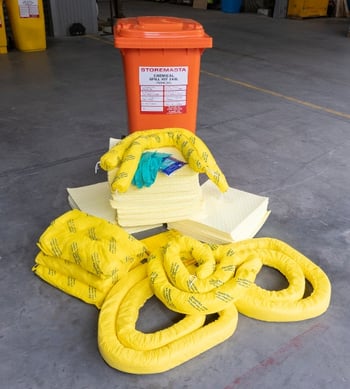No matter how many precautions you take, chemical emergencies can happen at any time (on any shift). This blog is all about emergency preparedness — the steps you need to take to ensure that your workers and property are safe before, during, and after a chemical emergency.
Planning for chemical emergencies involves:
- Developing an emergency plan
- Installing emergency equipment
- Implementing emergency response procedures
Steps To Emergency Response: Dangerous Goods
Preparation is key when dealing effectively with an emergency situation – particularly in circumstances which involve dangerous goods. Incidents can quickly turn into life-threatening situations when flammable liquid fires, toxic chemical spills or chemical reactions occur in a plan for a chemical emergency, we’ve created some key steps for handling an emergency response.
To help you understand the situation a little better, we’ll be using some generic examples to demonstrate the emergency planning process.
PLEASE NOTE: They are not intended as specific emergency response advice, and you should always conduct your own risk assessment that considers the unique nature of your workplace.
Developing an Emergency Plan
The first essential step in emergency preparedness is to develop and implement an emergency plan. Your emergency plan looks at the type of critical incidents that could take place (or affect) your worksite.
Examples of emergencies in a workplace may be incidents caused by natural disasters (bushfires, floods, cyclones), workplace accidents (including fires, toxic gas releases, chemical spills), external threats (bomb scares, armed hold ups) or other hazardous situations.
Whether you’re developing an on-site emergency plan for chemical industry operations or an emergency procedure guide for a small retail business, you must consider relevant laws, public health laws and disaster plans relevant to your state or territory.
Your emergency plan (otherwise referred to as an EP) puts in place evacuation procedures and other safety measures to protect your workers as well as the business.
An emergency plan is required under Division 4 of the WHS Regulations and requires you to take into consideration:
- Type of work being carried out (eg, truck refueling depot, small welder’s workshop)
- What chemical hazards are present (eg, 2 x 50,000 litre diesel tanks, welding fume from 2 x workers)
- Where the workplace is located (eg, remote site 250km from nearest emergency responders, shared industrial space with 6 other workshops in the same building)
- Scope of workplace including the number of buildings and physical area (eg, 3,600 sqm, 370 sqm).
- Number people could be working (or visiting) the job site during an emergency (10 workers + 3 drivers, 2 welders)
When developing your emergency plan you may need to consult with your local emergency service providers, as well as the owners of neighbouring properties and worksites. This is especially important when the worksite is remote or when your job site is in a shared space. Let’s look at the following two generic examples.
EXAMPLE 1: Remote fueling station.
Your workplace is located in a remote area of FNQ 250km from the nearest commercial centre. Consulting with regional councils and emergency services when developing your emergency plan will be essential.
EXAMPLE 2: Welding workshop
Your welding workshop is located in a shared industrial building, there are 6 workshops in the building. Your emergency plan must consider the activities of the other 5 tenants as well as the requirements of the landlord.

Your EP must consider your operations, your risks and all relevant laws.
Installing Emergency Equipment
Most emergency equipment is mandatory and required under WHS legislation and Australian Standards. When developing your emergency plan, you should conduct a risk assessment and consider your need for:
- Firefighting equipment (eg, extinguishers, hoses, hydrants, fire blankets)
- Chemical spill response kits (eg, neutralisers, absorbent materials, disposal containers)
- Alarm systems (eg, fire detection systems, emergency and distress alarms, toxic gas sensors)
- Emergency power and lighting, directional signs and evacuation drawings.
- First aid stations
- Emergency showers and eyewash facilities
- Personal Protective Equipment (eg, masks, respirators, chemical/fire resistant clothing, safety shields.)
The emergency equipment you install will relate to the specific needs of your job site, and must be always in working order and available for use during an emergency. It should be situated so it’s easy to grab and your workers must know how to use it safely.
Is your workplace equipped to deal with chemical emergencies, such as a hazardous spill?
Creating Emergency Response Procedures
Your emergency plan and emergency equipment is futile if your staff don’t know what to do. Take the time to develop procedures for different emergency situations, than reinforce this with regular training and drills. Your emergency procedures should include as a minimum:
- Raising the alarm - responding to smoke alarms, activating sirens, contacting emergency services, notifying stakeholders (neighbours, tenants, customers, suppliers, Council).
- Site evacuation - location of emergency exits and muster stations, assembly and verification of attendance records, searches for injured or missing personnel.
- Firefighting equipment - how to use extinguishers, fire blankets and fire hoses, understanding different classes of fires.
- First aid responses and treatment - basic first aid (CPR, treating chemical burns or exposure injuries), using safety showers and eyewash facilities, keeping yourself safe.
- Working with emergency responders - clearing roads and entry points for emergency vehicles, location of site maps and Manifest of hazardous chemicals.
- Personal safety training - staying low in a fire, using PPE correctly, caution when entering potentially unsafe zones, restrictions on rescue attempts.
- Chemical spills - how to neutralise acids and bases, safely containing a spill with absorbents and containers, cleaning up after a spill, recognising a major spill and initiating site evacuations or emergency assistance.
- Site security - controlling bystanders and unauthorised people, follow up integrity testing of HAZCHEM and Dangerous Goods stores.
Emergency procedures also include responses to other critical incidents eg, toxic gas alarms, essential equipment failure, power-cuts and blackouts, floods, storms, lightning strikes, accidents and bushfires on adjacent properties.
REMEMBER: The best approach to emergency preparedness is to have a complete understanding of the chemical hazards at your workplace and already have in place efficient housekeeping, chemical storage and handling systems.
Do You Have a Chemical Emergency Response Plan?
Emergency preparedness is a fundamental part of a compliant risk management plan. To learn how to begin the risk management process at your own workplace download our free eBook How to manage the risk of Hazardous Chemicals in the workplace. It introduces our 4-STEP risk management methodology and contains a set of practical tools and templates you can begin using immediately. Don’t miss out. Get your copy today.
Joining the team as a Dangerous Goods Storage Consultant, Melissa Hampton became Storemasta's Marketing Manager in late 2021. With extensive knowledge and experience in chemical compliance, Melissa is responsible for leading the Marketing team and helping shape their marketing strategy. In her spare time, you can find Melissa hiking, swimming and enjoying the great outdoors in beautiful north-west Tasmania.

